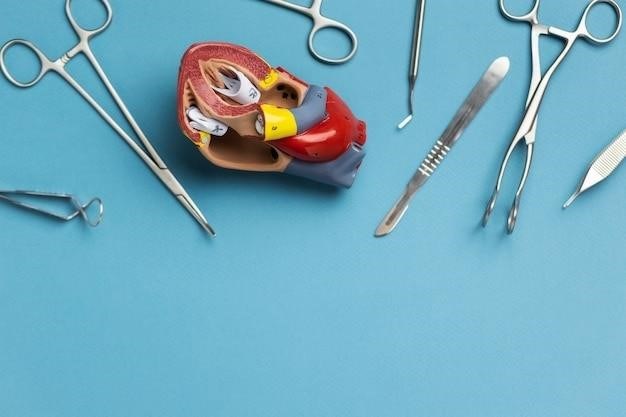Dental Instruments⁚ A Comprehensive Guide
This comprehensive guide will provide you with a detailed overview of dental instruments, covering their types, names, uses, and importance in dental practice. We will delve into the essential tools used in various dental procedures, including hygiene, examination, restorative, and surgical procedures. This guide will also include clear images and descriptions of each instrument, helping you visualize and understand their functionality.
This guide aims to provide a comprehensive resource for dental professionals, students, and anyone interested in learning about the world of dental instruments. It will equip you with the knowledge to identify different instruments, understand their applications, and appreciate their significance in maintaining oral health.

Introduction
Dental instruments are the essential tools that dentists and dental hygienists use to perform a wide range of procedures, from routine cleanings to complex surgeries. Understanding the names, functions, and proper use of these instruments is crucial for effective and safe dental care. This guide aims to provide a comprehensive overview of dental instruments, focusing on their names, pictures, and applications.
The world of dental instruments is vast and diverse, encompassing a wide array of tools designed for specific tasks. From basic instruments used for examination and hygiene to specialized instruments for restorative and surgical procedures, each tool plays a vital role in maintaining oral health. This guide will help you navigate this complex world by providing clear descriptions, images, and explanations of the most common dental instruments.
By familiarizing yourself with the names and pictures of these instruments, you will gain a better understanding of the tools used in dental procedures. This knowledge can be beneficial for both dental professionals and patients, fostering communication and trust in the dental setting.
Types of Dental Instruments
Dental instruments are categorized into different types based on their specific functions and applications in dental procedures. Understanding these categories is essential for comprehending the diverse world of dental tools and their roles in maintaining oral health. Here’s a breakdown of the primary types of dental instruments⁚
- Hygiene Instruments⁚ These instruments are primarily used for cleaning teeth and removing plaque, calculus, and debris. Examples include scalers, curettes, and probes.
- Examination Instruments⁚ These instruments are used for examining the teeth, gums, and oral cavity. They help dentists assess the condition of the teeth and identify any potential problems. Examples include mirrors, explorers, and periodontal probes.
- Restorative Instruments⁚ These instruments are used for restoring damaged or decayed teeth. They are used in procedures such as fillings, crowns, and bridges. Examples include burs, handpieces, and matrices.
- Surgical Instruments⁚ These instruments are used for performing surgical procedures in the mouth, such as extractions, biopsies, and implant placement. Examples include elevators, forceps, and bone chisels.
Each category encompasses a wide variety of instruments, each with its unique design and purpose. This guide will delve into the specific names and pictures of these instruments, providing a detailed understanding of their functions and applications in dental practice.
Hygiene Instruments
Hygiene instruments play a crucial role in maintaining oral health by removing plaque, calculus, and debris from teeth. These instruments are essential for preventing gum disease and promoting overall oral hygiene. Here are some common hygiene instruments and their descriptions⁚
- Scalers⁚ These instruments are used to remove calculus (hardened plaque) from the teeth. They come in various shapes and sizes, designed to reach different areas of the teeth. Scalers have sharp, pointed tips that scrape away calculus deposits.
- Curettes⁚ These instruments are similar to scalers but have a curved, spoon-shaped tip. Curettes are used for removing calculus from the root surfaces of teeth. They are particularly effective in removing calculus from deep pockets around the teeth.
- Probes⁚ These instruments are used to measure the depth of periodontal pockets (spaces between the teeth and gums). Probes have a thin, pointed tip that is inserted into the pocket to determine its depth. This information helps dentists assess the severity of gum disease.
- Prophy Brushes⁚ These brushes are used for polishing teeth after scaling and cleaning. They have a soft, rounded head that helps to remove surface stains and smooth the tooth surface.
These instruments are crucial for maintaining oral hygiene and preventing gum disease. By understanding the functions of these instruments, you can appreciate their role in maintaining a healthy smile.
Examination Instruments
Examination instruments are essential for dentists to thoroughly assess a patient’s oral health. These instruments allow dentists to visualize, explore, and evaluate the condition of teeth, gums, and surrounding tissues. Here are some common examination instruments and their descriptions⁚
- Mouth Mirror⁚ This instrument is used to reflect light into the mouth, allowing the dentist to see the teeth and surrounding tissues. It also helps to retract the patient’s cheeks and tongue, providing a clear view of the oral cavity.
- Dental Explorer⁚ This instrument has a thin, pointed tip that is used to explore the surfaces of teeth for cavities, cracks, and other irregularities. It also helps to detect plaque and calculus buildup.
- Periodontal Probe⁚ This instrument is used to measure the depth of periodontal pockets, which are spaces between the teeth and gums. It helps dentists assess the severity of gum disease and monitor its progress.
- Cotton Pliers⁚ These instruments are used to hold and manipulate cotton rolls, gauze, and other materials during dental procedures. They are also used to apply topical medications and sealants.
These instruments are critical for accurate diagnosis and treatment planning in dentistry. By understanding their functions, you can appreciate their role in maintaining optimal oral health.
Restorative Instruments
Restorative instruments are used to repair damaged teeth and restore their function and aesthetics. These instruments are essential for various procedures, including fillings, crowns, bridges, and inlays. Here are some commonly used restorative instruments⁚
- Dental Handpiece⁚ This instrument is a high-speed motor that rotates a variety of burs and other rotary instruments. It is used to prepare teeth for fillings, crowns, and other restorative procedures.
- Burs⁚ These are small, rotating cutting instruments that are used to shape and prepare teeth for restorations. They come in various shapes and sizes, depending on the specific procedure.
- Amalgam Carrier⁚ This instrument is used to hold and place amalgam, a silver-based filling material, into the prepared tooth cavity.
- Composite Instrument⁚ This instrument is used to place and shape composite resin, a tooth-colored filling material, into the prepared tooth cavity.
- Matrix Bands⁚ These are thin, metal bands that are used to create a temporary wall around the tooth during the placement of fillings. They help to ensure that the filling is properly shaped and contoured.
These instruments play a crucial role in restoring teeth to their optimal function and appearance. By understanding their functions, you can appreciate the importance of restorative dentistry in maintaining oral health.
Surgical Instruments
Surgical instruments are used for a wide range of dental procedures, from simple extractions to complex oral surgeries. These instruments are designed to cut, grasp, hold, and manipulate tissues, ensuring precise and safe procedures. Some of the most common surgical instruments include⁚
- Surgical Forceps⁚ These are specialized pliers used to grasp and hold teeth during extractions. Different forceps are designed for various tooth types and positions.
- Elevators⁚ These instruments are used to loosen teeth from their sockets before extraction. They come in various shapes and sizes, depending on the tooth’s location and position.
- Surgical Scalpel⁚ This instrument is used to make incisions in the gums and other tissues during oral surgery. It has a sharp blade attached to a handle for precise cutting.
- Surgical Curettes⁚ These instruments are used to scrape away soft tissue and debris during surgical procedures. They are often used to remove granulation tissue or to prepare the surgical site.
- Bone Files and Reamers⁚ These instruments are used to shape and contour bone during surgical procedures. They are essential for creating space for implants, grafts, or other procedures that involve bone manipulation.
Surgical instruments are essential tools for dental professionals, enabling them to perform complex procedures with precision and safety. Their use ensures optimal patient care and successful surgical outcomes.
Dental Instrument Names and Pictures
Visualizing dental instruments is crucial for understanding their function and application. This section will provide a comprehensive list of dental instrument names accompanied by clear pictures, making it easier to identify and comprehend their uses. This guide is designed to be a valuable resource for dental professionals, students, and anyone interested in learning about the tools of the trade.
By combining instrument names with visual representations, this guide offers a more engaging and accessible learning experience. It allows users to quickly recognize familiar instruments, understand their specific roles, and expand their knowledge of the diverse array of tools used in dentistry.
The inclusion of pictures alongside instrument names transforms this guide into a practical and informative resource. It bridges the gap between theoretical knowledge and real-world application, making the learning process more intuitive and enjoyable. This visual approach facilitates a deeper understanding of the instruments and their significance in dental practice.
Handpieces
Handpieces are the powerhouses of dental procedures, functioning as the primary tools for drilling, cutting, and polishing teeth. They are essentially miniature motors that connect to a dental chair’s air or electric source, providing the necessary power for various dental instruments.
There are two main types of handpieces⁚ high-speed and low-speed. High-speed handpieces operate at significantly higher revolutions per minute (RPM) than low-speed handpieces, making them ideal for procedures like cavity preparation and tooth removal. Low-speed handpieces, on the other hand, are used for tasks requiring more control and precision, such as polishing and finishing procedures.
Handpieces are versatile tools that are essential for a wide range of dental procedures. Their ability to deliver power and precision makes them indispensable instruments for dentists, enabling them to perform a variety of tasks effectively and efficiently.
The design and functionality of handpieces have evolved over time, incorporating technological advancements to enhance performance and improve operator comfort. Modern handpieces are lightweight, ergonomically designed, and equipped with features that reduce noise and vibration, contributing to a more pleasant experience for both the patient and the dentist.
Burs
Burs are the cutting tools that attach to dental handpieces, performing a variety of tasks in restorative and surgical procedures. They are essentially small, cylindrical instruments with a cutting head at one end. The cutting head is designed with various shapes and sizes, each tailored for specific applications in dentistry.
Burs are categorized into different types based on their material, shape, and purpose. Carbide burs are made from a durable, wear-resistant material, making them ideal for cutting and shaping tooth structure. Diamond burs, on the other hand, are designed for polishing and smoothing tooth surfaces, offering a finer cutting action.
The shape of a bur determines its function. Round burs are used for preparing cavities, while fissure burs are designed for cutting grooves. Other shapes, such as pear-shaped burs, are used for removing enamel and dentin.
The size of a bur is indicated by a number, with smaller numbers representing smaller burs. The number and shape of a bur are crucial factors in determining the type of procedure and the level of precision required.
Burs are essential instruments in dentistry, enabling dentists to prepare teeth for fillings, crowns, and other restorative procedures. Their versatility and precision make them indispensable tools in the hands of a skilled dentist.
Elevators
Elevators are specialized dental instruments designed to gently separate and remove teeth from their sockets during extractions. They are typically made from sturdy stainless steel and come in a variety of shapes and sizes, each tailored for specific tooth types and extraction procedures. The design of an elevator incorporates a blade-like tip that is inserted between the tooth root and the bone, leveraging the instrument to loosen the tooth;
The use of elevators requires a delicate touch and careful technique, as excessive force can damage surrounding tissues or fracture the tooth. The dentist will use a rocking motion to gently separate the tooth from its socket, ensuring that the extraction is performed safely and efficiently.
Elevators are classified based on their shape and design, each type suited for particular tooth positions and extraction challenges. For instance, root tip elevators are used to remove small fragments of teeth, while apical elevators are employed to dislodge teeth with deeply embedded roots.
The success of an extraction often depends on the proper use of elevators. These instruments play a crucial role in facilitating the removal of teeth without unnecessary trauma to the patient. Their unique design and careful application contribute to the safe and efficient extraction process.
Extraction Forceps
Extraction forceps are a vital tool used by dentists to remove teeth from the mouth during extractions. These instruments are specifically designed to grasp and apply force to the tooth, facilitating its removal from the socket. Constructed from durable stainless steel, extraction forceps are available in various shapes and sizes, each tailored to grip and extract specific tooth types.
The design of extraction forceps incorporates two beaks, which are the grasping points, and a handle for leverage. The beaks are crafted to fit snugly around the crown of the tooth, while the handle provides the dentist with a secure grip for applying controlled force.
The extraction process involves careful placement of the forceps onto the tooth, followed by a controlled rocking motion to loosen the tooth from its socket. The dentist must exercise caution to avoid excessive force, which could damage surrounding tissues or fracture the tooth.
Extraction forceps are categorized by their beak shape and size, indicating their suitability for specific tooth positions and extraction procedures. For example, universal forceps are used for multiple tooth types, while specific forceps are designed for molars, premolars, or incisors.
The proper use of extraction forceps is essential for a safe and successful tooth extraction. These instruments allow dentists to remove teeth efficiently while minimizing discomfort and potential complications.
Importance of Dental Instruments
Dental instruments are not mere tools; they are the foundation of modern dentistry, enabling practitioners to perform a wide range of procedures with precision, efficiency, and minimal discomfort for patients. Their importance extends far beyond the technical aspects of dental care; they play a crucial role in maintaining oral health, preventing complications, and enhancing the overall well-being of individuals.
The use of specialized instruments allows dentists to diagnose oral conditions accurately, identify potential problems early, and intervene effectively to prevent further deterioration. From examining teeth for cavities to performing complex restorative procedures, each instrument serves a distinct purpose, contributing to the success and quality of dental treatment.
Moreover, dental instruments are essential for ensuring patient safety. Their design, construction, and sterilization protocols are carefully implemented to minimize the risk of infection and cross-contamination. The use of sterile instruments promotes a clean and hygienic environment, protecting both patients and practitioners from potential health hazards.
In summary, dental instruments are indispensable tools for dental professionals, empowering them to deliver comprehensive oral care, maintain patient safety, and contribute to the overall health and well-being of their patients.


